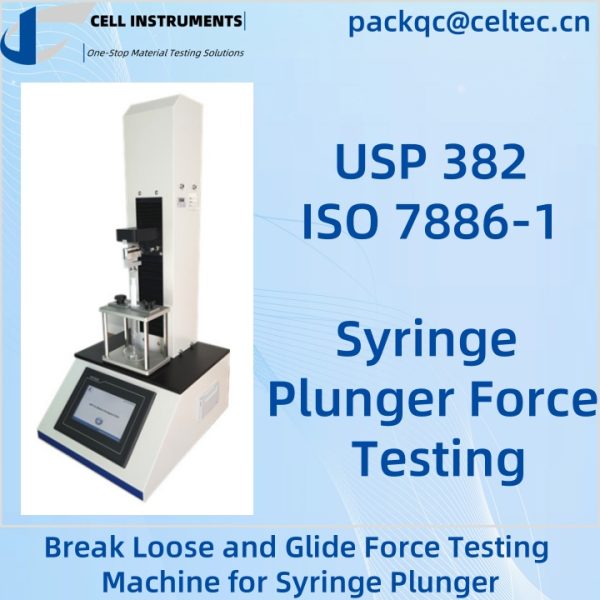Breaking Loose and Glide Force Testing
—— USP 382 and ISO 7886-1
Importance of Break Loose and Glide Force Testing
Break loose and glide force testing is a critical process in the quality control of packaging and medical devices, particularly in syringes. This test measures the force required to initiate movement (break loose force) and maintain movement (glide force) as the syringe plunger is engaged. The importance of these tests lies in their role in ensuring smooth operation, safety, and performance, especially in pharmaceutical and medical applications where precision is essential.
Testing for break loose and glide forces guarantees that syringes perform consistently under various conditions. By adhering to the industry standard USP 382, manufacturers can ensure that their products meet the necessary specifications for use in medical and pharmaceutical applications.
Break Loose Force vs. Glide Force
It’s important to distinguish between break loose force and glide force, as both have distinct implications for syringe performance:
- Break Loose Force: The initial force required to break the seal between the plunger and the barrel. This force ensures that the syringe will not leak or malfunction when first used.
- Glide Force: The continuous force required to keep the plunger moving after the initial break loose. It ensures the syringe delivers medication smoothly without sudden jerks or inconsistent flow.
Both forces are measured separately but are essential for understanding the overall performance of the syringe. Proper calibration of both forces guarantees smooth and reliable use.
Standards for Syringe Force Testing
USP 382 and ISO 7886-1 are key standards that outline the requirements for testing syringe plunger force. These standards ensure that syringes meet high performance and safety criteria. USP 382 focuses on the functional requirements of syringes, while ISO 7886-1 Annex E specifies the test methods for determining the forces required to operate the syringe piston, including the push plunger force test.
USP 382 syringe glide force testing
- Objective: Ensure syringe functionality and safety.
- Parameters: Initial force, maximum force, sustained force.
- Significance: Compliance guarantees reliable syringe performance in clinical settings.
ISO 7886-1 syringe glide force testing Annex E
- Objective: Measure the force required to move the plunger through the syringe barrel at a controlled speed.
- Procedure: Place the syringe in the tester and move the plunger at a predetermined rate.
- Parameters: Initial, maximum, and sustained forces are measured and compared against standard limits.
- Significance: Ensures syringes meet force requirements, crucial for safety and functionality.
How to Measure Break Loose Glide Force
- Preparation: The syringe is secured in a testing machine, and the plunger is positioned for the test.
- Break Loose Force Measurement: The initial force required to break the plunger’s seal is measured. This is known as the “break loose force” or the force needed to start the plunger’s movement.
- Glide Force Measurement: After the plunger moves, the test measures the continuous force required to keep it moving smoothly. This is called the “glide force.”
- Testing Conditions: The test is typically conducted under controlled environmental conditions, such as temperature, to ensure the results reflect real-world usage.
Test Equipment for Break Loose and Glide Force Testing
The Cell Instruments MST-01 Break Loose Glide Force Tester is designed to meet the rigorous demands of medical device testing. It provides precise measurements of the force required to push the plunger of a syringe, ensuring that each syringe meets the high standards of performance and safety required in medical and pharmaceutical applications.
Technical Specifications of MST-01
| Test Range | 50N (or as required) |
| Stroke | 200mm (without clamp) |
| Test Speed | 1~500mm/min |
| Displacement Accuracy | 0.01mm |
| Accuracy | 0.5% F.S. |
| Output | Screen, Microprinter, RS232(optional) |
| Power | 110~220V |
Key Features and Benefits
- Reliability and Precision: High accuracy and reliability with PLC control.
- Ease of Use: User-friendly interface for all skill levels.
- Durability: Built with high-quality materials for long-term use.
- Customer Support: Comprehensive support for installation, training, and maintenance.
FAQs about Break Loose and Glide Force Testing
A1: Breaking loose force testing measures the force required to initiate the movement of a syringe plunger within the barrel.
A2: Glide force testing ensures that the syringe plunger moves smoothly without excessive force, crucial for accurate and safe medication delivery.
A3: The MST-01 measures the force needed to push the syringe plunger, providing real-time data and analysis to ensure syringes meet performance standards.
A4: USP 382 and ISO 7886-1 are the key standards that outline the requirements for testing syringe plunger force.
A5: Yes, Cell Instruments offers customization options to adapt the tester for different syringe sizes and integrate additional features.



